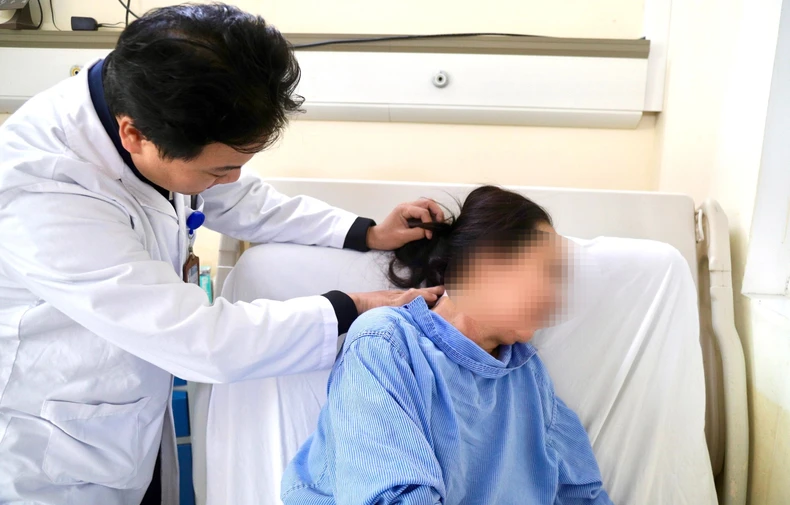Patient Vo Thi Q., 62 years old, residing in Xuan Hoi commune, Nghi Xuan district, Ha Tinh province, has had neck pain, numbness in legs and arms for about a year now. She has been treated with medication and acupuncture, which has sometimes reduced the condition. Recently, she has had more difficulty walking. Her family encouraged her to go to K Hospital for examination and discovered that the cause was a large tumor in the neck at the high cervical vertebrae, C2-C4, which had pressed on the spinal cord to the opposite side.
Dr. Nguyen Duc Lien, Head of the Department of Neurosurgery, said: “High cervical meningioma is a rare and difficult disease to treat. The high cervical cord has sensory-motor nerve fibers running through it, and there are also nerves that control breathing function and respiratory muscle function. Therefore, when removing the tumor, the spinal cord must be absolutely protected to avoid complications of complete paralysis and need for mechanical ventilation later. It must be performed with modern equipment such as microsurgery glasses, ultrasonic tumor suction knives, and experienced surgeons.”
Because the symptoms in the early stages are not too obvious, mainly pain, discomfort in the neck, back and some difficulty in movement, many people are often subjective, so in cases of prolonged neck pain or ineffective drug treatment, it is necessary to have a CT scan, MRI to detect the disease early. Symptoms of spinal cord tumors often last for many months and can be confused with other normal pains.
 |
The doctor checks the surgical wound after the tumor was removed. |
On December 7, the patient underwent microsurgery by doctors from the Department of Neurosurgery to remove the entire tumor that was dangerously compressing the cervical spinal cord. During the surgery, modern equipment was used, such as an intraoperative nerve warning system, microsurgical glasses, and an ultrasonic tumor suction knife.
After 5 hours, the doctors removed the entire tumor without damaging the spinal cord and nearby nerves. The application of the nerve warning system during surgery helps to provide early warning, minimizing damage to the spinal cord and nerves during surgery, helping patients recover quickly after surgery.
Up to now, the patient's health has recovered well, his limbs have clearer feeling, and he has started to walk again.
Ms. Q.'s child said: "My mother can move her limbs normally and eat normally the day after surgery. Our family is very happy." It is expected that the patient can do physical therapy and be discharged in the next few days.
It is known that before being treated for a large cervical spinal cord tumor, Ms. Vo Thi Q. had also been treated for early-stage lung cancer at K Hospital. During that time, she had surgery, then radiation therapy to maintain her health. Since then, Ms. Q. has been regularly traveling from Ha Tinh to Hanoi for medical examinations, placing all her trust in the doctors at K Hospital.
After the surgery, the patient emotionally shared that having had cancer twice and being treated by doctors at K Hospital, she felt very lucky. “At this age, I can still maintain my health and be happy with my children and grandchildren, which is truly the wish of many people. Since having surgery and radiation therapy for lung cancer in 2011 and now surgery for spinal cord tumor, I still have faith in the doctors at K Hospital. I and many other patients feel satisfied and secure,” Ms. Q. shared.






![[Photo] Party and State leaders visit former President Tran Duc Luong](https://vphoto.vietnam.vn/thumb/1200x675/vietnam/resource/IMAGE/2025/5/24/960db9b19102400e8df68d5a6caadcf6)


















![[Photo] Anh Hoang - Dinh Duc successfully defended the men's doubles championship of the National Table Tennis Championship of Nhan Dan Newspaper](https://vphoto.vietnam.vn/thumb/1200x675/vietnam/resource/IMAGE/2025/5/23/d6ab3bcac02c49928b38c729d795cac6)








































































Comment (0)